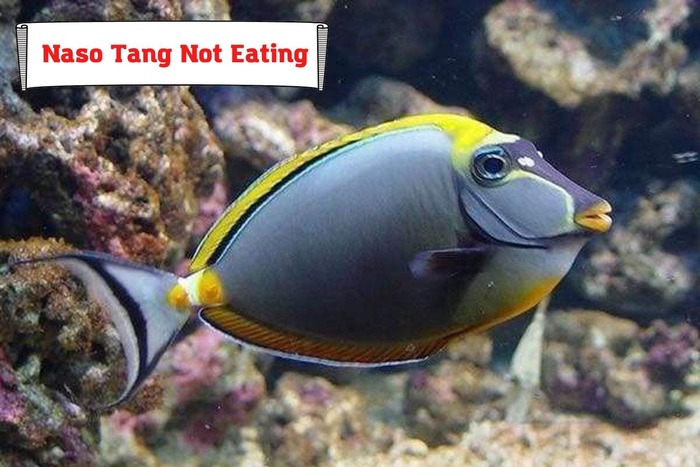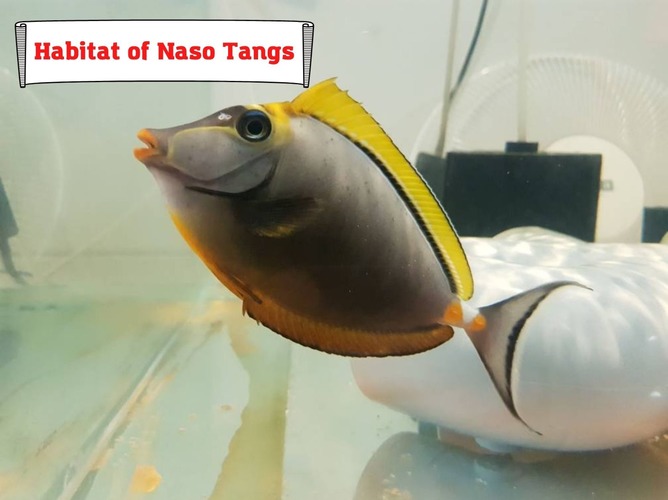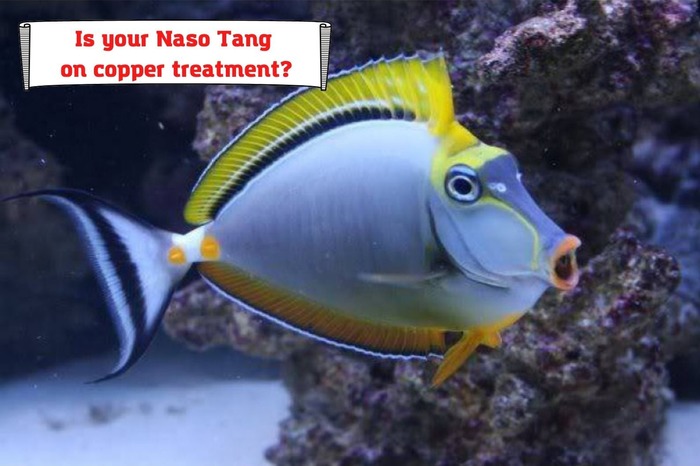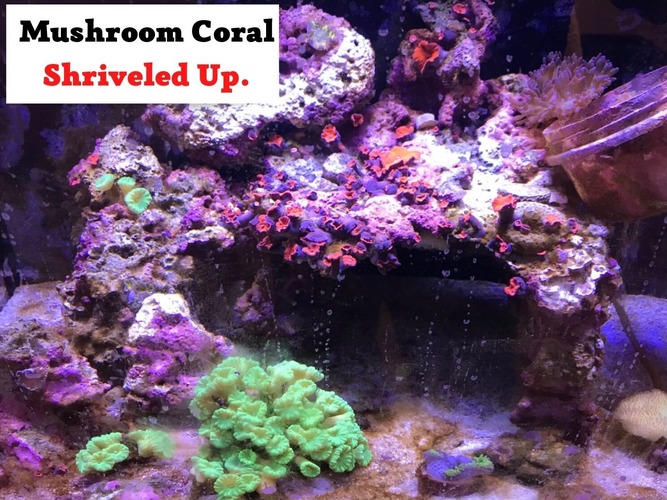
Adding tangs to your aquarium may be a good idea since they are among the most popular reef fish. Naso Tangs, sometimes referred to as surgeonfish or doctorfish, are an excellent choice for your reef aquarium for various reasons. There is a long list of Naso Tang species. In addition to its vivacity and charisma, Naso Tangs have a beautiful appearance to match.
Naso lituratus serves as a great representative for the most tranquil genus of surgeonfish globally. Naso or lipstick Tang (Naso lituratus) is among the favorite of marine aquarists from the early days of marine fish importation from the Philippine Islands.
This article contains:
- Essential facts about Tangs
- The behavior and habitat
- Eating habits of Naso Tang
- What to do when Naso Tang stops eating?
Essential facts about Tangs
Naso species may be found across the tropical Indian and Pacific seas. However, the majority of them are seldom obtained for aquariums at home. It has been demonstrated repeatedly that the species imported for the aquarium trade are resilient in the aquarium environment if their nutritional requirements are satisfied.
Unlike other unicornfish species, the Naso tang does not have projecting horns. Their skin is a bluish-gray shade of brown. A yellow line goes up to the rear of their lips from their eye and nose to the front. This line starts with a black point. Yellowish patches appear above the eye. An orange tint covers the lips.
The Naso genus is distinct from the rest of the “Acanthuridae” family because it has spine-like features on both sides of its tail, rather than just one. The caudal peduncle of this fish narrows as the fish lengthens. A pair of orange-tinged spines may be seen on each side of the caudal peduncle. Species of the Naso genus are all big herbivorous fish that are friendly and extroverted, and all of the extant species are popular with aquarium enthusiasts.
The behavior of Naso Tang
Naso Tangs are known for their calm and welcoming demeanor, and they’re a lot more active than you may expect. They like a reef- and coral-rich habitat in the sea. They spend the majority of their time swimming about and eating algae. They form strong bonds with other animals because of their kind attitude.
They can demonstrate territorial behavior both with and without other species. It is usual for them to prey on their species, the tangs and surgeonfishes.
Habitat of Naso Tangs

Tangs may be found chiefly on seaward reefs and lagoons. These fish may be found at a depth of 5 to 90 meters. They love to swim in water with a high oxygen concentration and strong currents. There are many similarities between their native environment and a reef tank, such as the abundance of algae growing on rock and decaying coral. This is why Tangs thrive in reef aquariums for various reasons.
For Naso tangs, water movement is crucial because they like having the water brush across their gills. Oxygen levels in the water must also be high. It is recommended that the water temperature is maintained around 24°C to 26°C. The water’s specific gravity should be between 1.020 and 1.025. You want your water’s acid-base balance to be between 8.1 and 8.4.
Naso Tangs have fantastic personalities in the aquarium and can be taught to take food out of their hands after being accustomed to life there. However, when it comes to territorial conflicts, it’s one of the most aggressive Surgeonfish species out there, particularly when it comes to other Surgeonfishes, especially of its type. The fact that they fight one another is an intriguing characteristic, given that they tend to gather in small groups or schools in the wild.
Eating habits of Naso Tang
Wild Naso Tang consume algae as their primary food source. You may augment your Tang’s diet with commercial herbivore pellets, dried or frozen marine algae, and some fresh vegetable matter in your home aquarium. Some tangs will eat meat, so be sure to do your homework before bringing one home. If you have corals in your reef tank, you’ll be protected from most Tangs, save for the larger tang species. Most tangs will leave your other tank residents alone if you feed them numerous times a day.
The algae are the most critical source of nutrition for Naso tangs, so the aquarium must have it in sufficient quantities. Flakes, zucchini, spinach, broccoli, lettuce, seaweeds can also prove to be a wonderful diet for the Naso Tang. Similarly, Enchytaeidae, as well as invertebrates such as mysid shrimps and brine shrimps can make a perfect meal.
Instead of eating the nori/algae sheets immediately, Tang fish graze on live rock. You should only provide your Tang with as much flake or pellet food as it can consume in a few minutes. To avoid contaminating the aquarium’s water, make sure to remove any leftovers.
Vitamin C must also be one of the essential food ingredients for the Naso Tang as it aids in minimizing the Lateral Line Erosion in the fish. You have to feed your pet three times a day to maintain its health. Avoiding the use of copper medications on a regular or lengthy basis is critical since they may kill the required microfauna found in the Naso tang’s digestive tract, which can be fatal.
What to do when Naso Tang stops eating?
As long as you acquire a fish that is already eating well, give it lots of areas, and supply it with plenty of macroalgae growth for grazing, the Naso Tang is a reasonably straightforward fish to care for. When you observe you Naso Tang has stopped eating, it is necessary to keep the following conditions.
Check the ammonia level of your fish tank
Sometimes your Naso Tang seems most sensitive to the ammonia level compared to the other fish in the reef tank and may stop eating. A fish tank with a maximum number of fish is hard to maintain with ammonia level down.
Never add prime to lower the ammonia level, making the copper toxic. 100% water change may bring a difference in this situation, and your Naso may start to act like himself.
Is your Naso Tang on copper treatment?

Copper is toxic. It has to last longer than the parasites, which can’t do that to be effective. To prevent your fish from being infected by newly born tomonts, add copper to the water (releasing free swimmers). This method works because the fish should be free of ich and velvet trophonts after 14 days. But this copper treatment may disturb your Naso Tang’s eating habits.
Copper suppresses the immune system and suppresses appetite. Thus fish often don’t feed during therapy. Together with a high ammonia level, this starving condition may stress the fish. Whether they don’t eat, reduce the copper amount and watch if they start eating.
Check for pinched stomach
Be alert about the lethargic condition of your Tang with a pinched stomach and burst of fast swimming. All these conditions indicate the presence of an intestinal parasite in your Naso Tang. It is not very difficult to cure, and you just need to isolate your Naso in QT with medicine.
Sometimes the same conditions appear in Naso due to intake of not enough greens. Maybe you are giving too much protein. Try to provide Omega with garlic or introduce aquaculture Mini Marine Grazer that smells like seaweed. You can give it 3-4 times in the evening, and they can graze overnight.
Have you added more than one Naso Tang in your fish tank?
Small surgeons may be kept together, but it relies on each individual’s arrangement and characteristics. Putting too many tangs in a small container usually backfires. It’s advisable to simultaneously introduce many tangs to your cage.
Remember that retaining a tang school isn’t always easy. Be prepared and have replacement tanks or a pet shop ready to take your pet if things don’t go as planned. Tangs need to have access to a swimming pool since it aids in digestion and reduces their stress levels.
Is it a new member of your fish tank?
A Naso can spend a longer time without food than you may expect. Your new Naso Tang may be frightened by the move and refuse to eat or hide from you.
Leaving the fish alone is the best thing you can do right now. Ammonia spikes may be disastrous and a self-fulfilling prophesy if you don’t give enough time to settle down and become hungry before feeding.
Does your Naso Tang like the food you give?
Most Naso Tang owners prefer green sheets for their Naso. However, fish tend to favor brown algae sheets (intense red). Providing sheets with garlic, like Ocean Nutrient, is also an excellent idea.
Blonde Naso Tang is a monster eater, but exclusively of algae sheets with garlic. They only eat meat when it’s live baby brine or frozen krill in an angel food combo. They despise freezing brine and Mysis.
Conclusion
Various reasons may cause your Naso Tang to stop eating. Some of these issues are casual and may disappear with time, such as early shyness in an aquarium, limited space, or presence of the same species. But the other reasons are pretty alarming and may result in the life loss of dear Naso Tang.
- Pleco Not Eating. Main Reasons Your Pleco Is Starving - February 21, 2022
- Foxface Fish Sting: Any Danger? And What To Do To Relieve Pain? - February 20, 2022
- White Stuff Coming Out Of Snail – Dangerous? Should You Worry About It? - February 19, 2022




